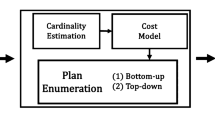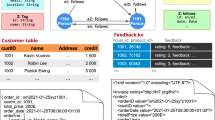Abstract
One of the main objectives of third generation databases is to design database management systems which provide users with more and more functionalities. In such a wide context, various proposals have been made in order to introduce some kind of explicit or implicit flexibility into user queries. In this paper, we propose a classification of the various approaches dealing with imprecise queries. Moreover, we show that the approach based on fuzzy sets is powerful enough to answer a wide range of imprecise queries in an appropriate way and to support the expression of the capabilities available in the other classes of solutions. An outline of an SQL-like language allowing for a variety of imprecise queries is also presented.
Similar content being viewed by others
References
Bosc, P., Galibourg, M., and Hamon, G. (1988). Fuzzy Querying with SQL: Extensions and Implementation Aspects.Fuzzy Sets and Systems, 28, 333–349.
Bosc, P. and Pivert, O. (1991a). Some Algorithms for Evaluating Fuzzy Relational Queries.Lecture Notes in Computer Science, vol. 521, pp. 431–442.
Bosc, P. and Pivert, O. (1991b). On the evaluation of simple fuzzy relational queries.Proc. 4th IFSA World Congress, (pp. 9–12), Brussels, Belgium.
Bosc, P. and Pivert, O. (1991c). About equivalences in SQLf, a relational language supporting imprecise querying.Proc. Int. Fuzzy Engineering Symp. (309–320), Yokohama, Japan.
Bosc, P. and Pivert, O. (1992). Fuzzy Querying in Conventional Databases. In J. Kacprzyk and L. Zadeh (Eds.),Fuzzy Logic for the Management of Uncertainty, New York: Wiley.
Bouchon-Meunier, B. and Yao, J. (1992). Linguistic Modifiers and Imprecise Categories.Journal of Intelligent Systems, to appear.
Chamberlin, D.D., et al. (1976). SEQUEL2: A Unified Approach to Data Definition, Manipulation and Control.IBM Journal of Research and Development, 20, 560–575.
Chang, C.L. (1982). Decision Support in an Imperfect World. Research Report RJ3421, IBM San José, CA.
D'Atri, A. and Tarantino, L. (1989). From Browsing to Querying.Data Engineering Bulletin, 12, 47–53.
Dubois, D. and Prade, H. (1985). A Review of Fuzzy Set Aggregation Connectives.Information Sciences, 36, 85–121.
Dubois, D. and Prade, H. (1986). Weighted Minimum and Maximum Operations in Fuzzy Set Theory.Information Sciences, 39, 205–210.
Dyckhoff, H. and Pedrycz, W. (1984). Generalized Means as a Model of Compensative Connectives.Fuzzy Sets and Systems, 14, 143–154.
Friedman, J.H., Baskett, F., and Shustek, L.J. (1975). An Algorithm for Finding Nearest Neighbors.IEEE Transactions on Computers, 1001–1006.
Gal, A. (1988). Cooperative Responses in Deductive Databases. Technical Report CS-TR-2075, Department of Computer Science, University of Maryland, MD.
Guyomard, M. and Siroux, J. (1989). Suggestive and Corrective Answers: A Single Mechanism. In M.M. Taylor, F. Néel and D.G. Bouwhuis (Eds.),The Structure of Multimodal Dialogue, pp. 361–374. Amsterdam: North-Holland.
Ichikawa, T. and Hirakawa, M. (1986). ARES: A Relational Database with the Capability of Performing Flexible Interpretion of Queries.IEEE Transactions on Software Engineering, 12, 624–634.
Janas, J.M. (1981). On the Feasibility of Informative Answers. In H. Gallaire, J. Minker, and J-M. Nicolas (Eds.),Advances in Database Theory, New York: Plenum Press.
Kacprzyk, J. and Ziolkowski, A. (1986). Database Queries with Fuzzy Linguistic Quantifiers.IEEE Transactions on Systems, Man and Cybernetics, 16, 474–478.
Kaplan, J. (1982). Cooperative Responses from a Portable Natural Language Database Query System. In M. Brady (Ed.),Computational Models of Discourse, Cambridge, MA: MIT Press.
Kunii, T.L. (1976). Dataplan: An Interface Generator for Database Semantics.Information Sciences, 10, 279–298.
Lacroix, M. and Lavency P. (1987). Preferences: putting more knowledge into queries.Proc. 13rd VLDB Conf. (pp. 217–225), Brighton, Great Britain.
Lakoff, G. (1973). Hedges: A Study in Meaning Criteria and the Logic of Fuzzy Concepts.Journal of Philosophical Logic, 2, 458–508.
Motro, A. (1986). BAROQUE: A Browser for Relational Databases.ACM Transactions on Office Information Systems, 4, 164–181.
Motro, A. (1988). VAGUE: A User Interface to Relational Databases That Permits Vague Queries.ACM Transactions on Office Information Systems, 6, 187–214.
Motro, A. (1989). A Trio of Database User Interfaces for Handling Vague Retrieval Requests.Data Engineering Bulletin, 12, 54–63.
Rivest, R.L. (1976). Partial Match Retrieval Algorithms.SIAM Journal of Computing, 5, 19–50.
Tahani, V. (1977). A Conceptual Framework for Fuzzy Query Processing; A Step toward Very Intelligent Database Systems.Information Processing and Management, 13, 289–303.
Yager, R.R. (1988). On Ordered Weighted Averaging Aggregation Operators in Multicriteria Decisionmaking.IEEE Transactions on Systems, Man and Cybernetics, 18, 183–190.
Yager, R.R. (1991a). Connectives and Quantifiers in Fuzzy Sets.Fuzzy Sets and Systems, 40, 39–75.
Yager, R.R. (1991b). Fuzzy Quotient Operators for fuzzy relational databases.Proc. Int. Fuzzy Engineering Symp., (pp. 289–296), Yokohama, Japan.
Yager, R.R. (1991c). Non-Monotonic Set Theoretic Operations.Fuzzy Sets and Systems, 42, 173–190.
Yong-Yi, C. (1981). An Approach to Fuzzy Operators.BUSEFAL, 9, 59–65.
Zadeh, L.A. (1965). Fuzzy Sets.Information and Control, 8, 338–353.
Zadeh, L.A. (1972). A Fuzzy-Set-Theoretic Interpretation of Linguistic Hedges.Journal of Cybernetics, 2, 4–34.
Zadeh, L.A. (1983). A Computational Approach to Fuzzy Quantifiers in Natural Languages.Computer Mathematics with Applications, 9, 149–183.
Zimmermann, H.J. and Zysno, P. (1980). Latent Connectives in Human Decision Making.Fuzzy Sets and Systems, 4, 37–51.
Author information
Authors and Affiliations
Rights and permissions
About this article
Cite this article
Bosc, P., Pivert, O. Some approaches for relational databases flexible querying. J Intell Inf Syst 1, 323–354 (1992). https://doi.org/10.1007/BF00962923
Issue Date:
DOI: https://doi.org/10.1007/BF00962923




